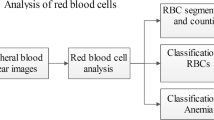Summary
A technique is described to detect bromodeoxyuridine (BrdU) incorporate by cells in S-phase, with a monoclonal antibody, using removable plastic embedding and immunogold-silver staining (IGSS). The incubation times were reduced and the immunological reactions enhanced by microwave irradiation.
The embedding in methyl methacrylate enabled us to make thinner sections and it improved the quality of the preparations. The methyl methacrylate did not hinder the reaction of BrdU with the antibody because it could be removed prior to the IGSS procedure. The IGSS procedure appeared to be very sensitive, requiring lower concentrations of the antibodies than other methods. The use of microwave irradiation shortened the time needed to stain a section from 7 to less than 4 h. Furthermore, using microwave irradiation, the concentration of the antibodies needed could be reduced even further compared with the normal IGSS procedure.
In sections of the mouse testis and small intestine only nuclei of cells known to be able to proliferate appeared BrdU positive. The non-specific background staining was found to be negligible. In testes of mice that received both3H-thymidine and BrdU more than 95% of the radioactively labelled cells also showed BrdU label and vice versa. This indicates that both methods are equally sensitive for detecting cells in S-phase.
Similar content being viewed by others
References
Boon, M. E. &Kok, L. P. (1987)Microwave Cookbook of Pathology: The Art of Microscopic Visualization, pp. 135–138. Leiden: Coulomb Press Leyden.
Cho, K. G., Hoshino, T., Nagashima, T., Murovic, J. A. &Wilson, C. B. (1986) Prediction of tumor double time in recurrent meningiomas: cell kinetics studies with bromodeoxyuridine.J. Neurosurg. 65, 790–4.
Fabrikant, J. I. (1979) Cell cycle of spermatogonia in mouse testis.Invest. Radiol. 14, 189–91.
Gratzner, H. G. (1982) Monoclonal antibody to 5-bromo- and 5-iododeoxyuridine: a new reagent for detection of DNA replication.Science 218, 474–5.
Gunduz, N. (1985) The use of FITC-conjugated monoclonal antibodies for determination of S-phase cells with fluorescence microscopy.Cytometry 6, 597–601.
Harms, G., Van Goor, H., Koudstaal, J., De Ley, L. &Hardonk, M. J. (1986) Immunohistochemical demonstration of DNA-incorporated 5-bromodeoxyuridine in frozen and plastic embedded sections.Histochemistry 85, 139–43.
Hilscher, W. &Maurer, W. (1962) Autoradiographische Bestimmung der Dauer der DNS-Verdopplung und ihres zeitlichen Verlaufs bei Spermatogonien der Ratte druch Doppelmarkierung mit C-14- und H-3-Thymidin.Naturwissenschaften 49, 352–4.
Hoshino, T., Nagashima, T., Murovic, J. A., Wilson, C. B. &Davis, R. L. (1986) Proliferative potential of human meningiomas of the brain: a cell kinetics study with bromodeoxyuridine.Cancer 58, 1466–72.
Langer, E. M., Röttgers, H. R., Schliermann, M. G., Meier, E. M., Miltenberger, H. G., Schumann, J. &Göhde, W. (1985) Cycling S-phase cells in animal and spontaneous tumours. I. Comparison of the BrdUrd and3H-thymidine techniques and flow cytometry for the estimation of S-phase frequency.Acta Radiol. Oncol. 24, 545–8.
Leong, A. S. &Milios, J. (1986) Rapid immunoperoxidase staining of lymphocyte antigens using microwave irradiation.J. Pathol. 148, 183–95.
Monesi, V. (1962) Autoradiographic study of DNA synthesis and the cell cycle in spermatogonia and spermatocytes of mouse testis using tritiated thymidine.J. Cell Biol. 14, 1–18.
Morstyn, G., Pyke, K., Gardner, J., Ashcroft, R., De Fazio, A. &Bhathal, P. (1986) Immunohistochemical identification of proliferating cells in organ culture using bromodeoxyuridine and a monoclonal antibody.J. Histochem. Cytochem. 34, 697–701.
Raza, A., Ucar, K., Bhayana, R., Kempski, M. &Preisler, H. D. (1985) Utility and sensitivity of anti BrdU antibodies in assessing S-phase cells compared to autoradiography.Cell Biochem. Funct. 3, 149–53.
Sasaki, K., Ogino, T. &Takahashi, M. (1986) Immunological determination of labelling index on human tumour tissue sections using monoclonal anti-BrdUrd antibody.Stain Technol. 61, 155–61.
Sugihara, H., Hattori, T. &Fukuda, M. (1986) Immunohistochemical detection of bromodeoxyuridine in formalin-fixed tissues.Histochemistry 85, 193–5.
Wynford-Thomas, D. &Williams, E. D. (1986) Use of bromodeoxyuridine for all kinetic studies in intact animals.Cell Tissue Kinet. 19, 179–82.
Author information
Authors and Affiliations
Rights and permissions
About this article
Cite this article
Van de Kant, H.J.G., Boon, M.E. & De Rooij, D.G. Microwave-aided technique to detect bromodeoxyuridine in S-phase cells using immunogold-silver staining and plastic-embedded sections. Histochem J 20, 335–340 (1988). https://doi.org/10.1007/BF01002726
Received:
Revised:
Issue Date:
DOI: https://doi.org/10.1007/BF01002726




